 4
ALL NIGHT HORROR MARATHON VOLUME ONE: WHAT’S THE MATTER WITH HELEN? (1971)/THE
VAGRANT (1992)/THE GODSEND (1980)/THE OUTING (1987)
4
ALL NIGHT HORROR MARATHON VOLUME ONE: WHAT’S THE MATTER WITH HELEN? (1971)/THE
VAGRANT (1992)/THE GODSEND (1980)/THE OUTING (1987)Directors: Curtis Harrington/Chris Walas/Gabrielle Beaumont/Tom Daley
Scream Factory/Shout! Factory
 4
ALL NIGHT HORROR MARATHON VOLUME ONE: WHAT’S THE MATTER WITH HELEN? (1971)/THE
VAGRANT (1992)/THE GODSEND (1980)/THE OUTING (1987)
4
ALL NIGHT HORROR MARATHON VOLUME ONE: WHAT’S THE MATTER WITH HELEN? (1971)/THE
VAGRANT (1992)/THE GODSEND (1980)/THE OUTING (1987)Shout! Factory delves into the MGM vaults for an odd quartet that is Scream Factory’s ALL NIGHT HORROR MARATHON VOLUME ONE.

Shout! Factory originally announced this set with Lucio Fulci’s A LIZARD IN A WOMAN’S SKIN – under the AIP release title SCHIZOID – until rights issues cropped up (although MGM provided Shriek Show with the master for their first DVD release of the film, the actual US home video rights belonged to another party). This delayed the release of the set from August to early October, during which the Fulci film was replaced with Curtis Harrington’s WHAT’S THE MATTER WITH HELEN. After their sons are convicted of the brutal slaying of a middle-aged woman, stage school teacher Adele (Debbie Reynolds, SINGIN’ IN THE RAIN) and seamstress Helen (Shelly Winters, NIGHT OF THE HUNTER) – who have been receiving death threats over the telephone (“I want to see you bleed!”) throughout the trial – flee New York to start a new life in California. Adele founds a new school to train Shirley Temple hopefuls in tap dancing in anticipation of an upcoming revue rumored (by Adele) to be attended by studio talent scouts. Adele tries to forget the past and begins a romance with Linc Palmer (Dennis Weaver, DON’T GO TO SLEEP), the father of one of her pupils. Religious and repressed Helen is resentful of their relationship and believes that they are being punished for their children’s actions (and by their children since she points out that the woman they killed was a working woman like them and claims Adele neglected her son and her own son blames her for his father’s grisly accidental death). Soon the obscene calls start up again and someone sends a newspaper clipping about the trial to Linc. Helen believes that the person who threatened them has found them again, but Adele thinks it’s all in Helen’s mind.
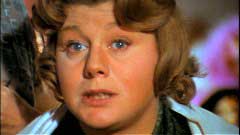 WHAT’S
THE MATTER WITH HELEN? is one of the lesser works of its screenwriter Henry
Farrell, a novelist who struck gold with his 1960 novel “What Ever Happened
to Baby Jane?” which of course became the Robert Aldrich Bette Davis/Joan
Crawford hit in 1962 (followed by hundreds of TV parodies and a lesser TV adaptation
in 1991 with Vanessa and Lynn Redgrave). Farrell would then quickly collaborate
with Lukas Heller on the follow-up adaptation of his Southern Gothic short story
“What Ever Happened to Cousin Charlotte” for Aldrich’s 1964
grislier but less grueling HUSH, HUSH SWEET CHARLOTTE (keeping Davis but switching
Crawford for Olivia de Havilland). His 1959 novel “The Hostage”
was adapted in 1967 without his involvement, and a West German TV adaptation
of his 1963 novel “How Awful About Allan” preceded his own scripted
1970 TV version (with Anthony Perkins and Julie Harris), which was directed
by Harrington. Just before HELEN, he had adapted his own novel “The Eyes
of Charles Sand” for television as well as adapting the memorably creepy
“The House That Would Not Die” (based on Barbara Michaels’
“Ammie, Come Home”). Despite fine complex characterizations by Reynolds
and Winters – and wonderfully monstrous ones from THE BAT’s Agnes
Moorehead (as radio evangelist Sister Alma) and TOM JONES’ Micheál
MacLiammóir as the appropriately theatrical elocution expert –
everything feels a bit too familiar, and most of the hysteria is shoved to the
last twenty minutes. The cinematography of Lucien Ballard (THE WILD BUNCH) emulates
the look of films from the 1930s (and Ballard had been working since then),
particularly with the sumptuous close-ups of Reynolds (even Weaver looks like
an “Old Hollywood” leading man here). Director Curtis Harrington
followed this up with the more entertaining British-lensed WHO SLEW AUNTIE ROO?
in which Winters combined HELEN’s two characters into one ex-showbiz nutjob.
WHAT’S
THE MATTER WITH HELEN? is one of the lesser works of its screenwriter Henry
Farrell, a novelist who struck gold with his 1960 novel “What Ever Happened
to Baby Jane?” which of course became the Robert Aldrich Bette Davis/Joan
Crawford hit in 1962 (followed by hundreds of TV parodies and a lesser TV adaptation
in 1991 with Vanessa and Lynn Redgrave). Farrell would then quickly collaborate
with Lukas Heller on the follow-up adaptation of his Southern Gothic short story
“What Ever Happened to Cousin Charlotte” for Aldrich’s 1964
grislier but less grueling HUSH, HUSH SWEET CHARLOTTE (keeping Davis but switching
Crawford for Olivia de Havilland). His 1959 novel “The Hostage”
was adapted in 1967 without his involvement, and a West German TV adaptation
of his 1963 novel “How Awful About Allan” preceded his own scripted
1970 TV version (with Anthony Perkins and Julie Harris), which was directed
by Harrington. Just before HELEN, he had adapted his own novel “The Eyes
of Charles Sand” for television as well as adapting the memorably creepy
“The House That Would Not Die” (based on Barbara Michaels’
“Ammie, Come Home”). Despite fine complex characterizations by Reynolds
and Winters – and wonderfully monstrous ones from THE BAT’s Agnes
Moorehead (as radio evangelist Sister Alma) and TOM JONES’ Micheál
MacLiammóir as the appropriately theatrical elocution expert –
everything feels a bit too familiar, and most of the hysteria is shoved to the
last twenty minutes. The cinematography of Lucien Ballard (THE WILD BUNCH) emulates
the look of films from the 1930s (and Ballard had been working since then),
particularly with the sumptuous close-ups of Reynolds (even Weaver looks like
an “Old Hollywood” leading man here). Director Curtis Harrington
followed this up with the more entertaining British-lensed WHO SLEW AUNTIE ROO?
in which Winters combined HELEN’s two characters into one ex-showbiz nutjob.
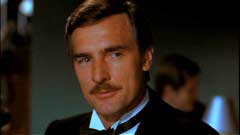
Prefaced with an Orion logo, the interlaced 1.78:1 anamorphic transfer on the Scream Factory set is likely from the same master that MGM used on their 2002 DVD (paired with a 4:3 letterboxed transfer of WHO SLEW AUNTIE ROO?). The colors are saturated when appropriate – lending life to the wardrobe and bloodshed – but the skintones are a touch too orange and the shadows a bit muddy, possibly due to an attempt to emulate the look of 1930s color films. The overall image also looks quite flat (an early shot of Reynolds next to her cardboard cutout has both looking rather artificial) but this seems to be more a fault of the older master than Shout!’s encoding. The Dolby Digital 2.0 mono track is fine. The MGM release’s only extra was a theatrical trailer (in addition to a Spanish dub and English and French subtitle options) that has not been reproduced here.
 In
THE VAGRANT, statistician Graham Krakowski (Bill Paxton, MORTUARY) buys a fixer-upper
across from a vacant lot for himself and his long-distance fiancée Edie
(Mitzi Kapture, TV’s SILK STALKINGS). He quickly finds more to worry about
than leaky faucets and mice in the basement when a particularly scary-looking
vagrant (Marshall Bell, A NIGHTMARE ON ELM STREET 2: FREDDY’S REVENGE)
not only takes up residence in the lot across the street, but also has a habit
of letting himself into Graham’s home. Graham gets the police to arrest
the vagrant for public urination, but he is soon let go and continues to make
appearances in Graham’s home. Graham takes out a second mortgage to install
a state-of-the-art security system, but the vagrant continues to make appearances
in his house and in his dreams. Is Graham simply paranoid or is the vagrant
really out to get him? When Graham’s elderly neighbor is gruesomely murdered,
Graham goes to the police but his erratic behavior makes him seem like even
more of a likely suspect to the investigating detective (Michael Ironside, SCANNERS);
especially when Graham’s hot-to-trot realtor (Colleen Camp, CLUE) mysteriously
vanishes after bedding him to dissuade him from selling the house.
In
THE VAGRANT, statistician Graham Krakowski (Bill Paxton, MORTUARY) buys a fixer-upper
across from a vacant lot for himself and his long-distance fiancée Edie
(Mitzi Kapture, TV’s SILK STALKINGS). He quickly finds more to worry about
than leaky faucets and mice in the basement when a particularly scary-looking
vagrant (Marshall Bell, A NIGHTMARE ON ELM STREET 2: FREDDY’S REVENGE)
not only takes up residence in the lot across the street, but also has a habit
of letting himself into Graham’s home. Graham gets the police to arrest
the vagrant for public urination, but he is soon let go and continues to make
appearances in Graham’s home. Graham takes out a second mortgage to install
a state-of-the-art security system, but the vagrant continues to make appearances
in his house and in his dreams. Is Graham simply paranoid or is the vagrant
really out to get him? When Graham’s elderly neighbor is gruesomely murdered,
Graham goes to the police but his erratic behavior makes him seem like even
more of a likely suspect to the investigating detective (Michael Ironside, SCANNERS);
especially when Graham’s hot-to-trot realtor (Colleen Camp, CLUE) mysteriously
vanishes after bedding him to dissuade him from selling the house.
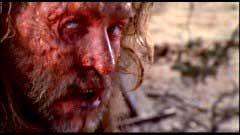
THE VAGRANT could have been a tense but blackly comic study of paranoia (kind of a REPULSION with a male protagonist or even THE TENANT to reference another Polanski film), but this Brooksfilm (executive producer Mel Brooks) production tries to be quirky instead with its Danny Elfman-esque score by the usually great Christopher Young (JENNIFER 8), grotesque characterizations, surreal nightmares, and an entire faux-expressionist arrest and trial sequence before arriving at is rather dissatisfying conclusion. Paxton has always been a quirky actor and he transitions from uptight yuppie to bemulletted redneck more effortlessly than the script’s characterization, but Ironside is over the top from the get-go and Bell is just a bellowing bogeyman beneath the prosthetic make-up of effects man-turned-director Chris Walas (THE FLY). Marc McClure (SUPERMAN), Stuart Pankin (HANGAR 18), Teddy Wilson (CLEOPATRA JONES), and Patrika Darbo (TV’s DAYS OF OUR LIVES) also star. Shout!’s MGM-sourced anamorphic widescreen (1.85:1) transfer of THE VAGRANT is also interlaced but it’s the best looking of the transfers on the set by virtue of its relative age. The Dolby Digital 2.0 stereo track is the most adventurous of the four films on the set with Young’s score and the surreal hallucinations.
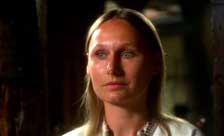 In
THE GODSEND, artist Alan Marlowe (Malcolm Stoddard, RAIN ON THE ROOF) and his
aspiring writer wife Kate (Cyd Hayman, MASK OF MURDER) live in the country with
their four children. One day they are visited by a strange young pregnant woman
(Angela Pleasence, SYMPTOMS) who goes into labor and disappears the next morning
leaving the baby behind. Although Kate immediately becomes attached to the child,
Alan is uncertain about keeping her until their infant son dies in the crib
shared by the two children. In order to help Kate get over the death, he agrees
to adopt whom they christen Bonnie (“because of her bonnie blue eyes”).
As Bonnie grows up she becomes more attached to Kate and starts to come between
her and Alan. When their older son Davy mysteriously drowns on a picnic outing,
Alan gets the first inkling that something may not be right with Bonnie despite
the fact that she’s only a toddler; and he is more suspicious when middle
son Sam and daughter are afraid to be alone with Bonnie. Sam’s accidental
death drives the family to the city not because of bad memories but because
of harassment from suspicious locals and the local press. When Alan believes
he witnesses Bonnie attempt to kill daughter Lucy, he insists that they send
Bonnie away; but Kate will not hear of it, and Bonnie seems determined to have
her mother to herself.
In
THE GODSEND, artist Alan Marlowe (Malcolm Stoddard, RAIN ON THE ROOF) and his
aspiring writer wife Kate (Cyd Hayman, MASK OF MURDER) live in the country with
their four children. One day they are visited by a strange young pregnant woman
(Angela Pleasence, SYMPTOMS) who goes into labor and disappears the next morning
leaving the baby behind. Although Kate immediately becomes attached to the child,
Alan is uncertain about keeping her until their infant son dies in the crib
shared by the two children. In order to help Kate get over the death, he agrees
to adopt whom they christen Bonnie (“because of her bonnie blue eyes”).
As Bonnie grows up she becomes more attached to Kate and starts to come between
her and Alan. When their older son Davy mysteriously drowns on a picnic outing,
Alan gets the first inkling that something may not be right with Bonnie despite
the fact that she’s only a toddler; and he is more suspicious when middle
son Sam and daughter are afraid to be alone with Bonnie. Sam’s accidental
death drives the family to the city not because of bad memories but because
of harassment from suspicious locals and the local press. When Alan believes
he witnesses Bonnie attempt to kill daughter Lucy, he insists that they send
Bonnie away; but Kate will not hear of it, and Bonnie seems determined to have
her mother to herself.
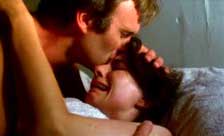
Based on a 1975 novel by Bernard Taylor (MOTHER’S BOYS) of the same name, Cannon’s THE GODSEND was likely greenlit after the success of THE OMEN; however, it plays like an overlong HAMMER HOUSE OF HORROR episode – somewhere between “Growing Pains” and “The House That Bled to Death”, both of which were shot the same year by the film’s cinematographer Norman Warwick – without the gruesomeness (despite the body count consisting entirely of children). The placid atmosphere of the film’s first half extends not only to the score by Roger Webb (BURKE & HARE) but also to the pacing and the execution, with the camera often cutting away from the discovery of the deaths before any hysterics on the part of the parents to later that night or the next day after they have calmed down; as such, there are just disturbing incidents rather than horror set-pieces. Neither Pleasence’s disquieting stare nor Stoddard’s uneasiness can wring out any tension from the opening or the circular ending scenes. In spite of the film’s demerits, seeing it for the first time (especially on a wintry day) is like discovering a lost British horror film (of which there were precious few in the early 1980s outside of the television medium). The screenplay was written by actor Olaf Pooley who had previously written and co-starred in the more ambiguous, arty, and atmospheric CRUCIBLE OF HORROR which was produced by THE GODSEND’s director Gabrielle Beaumont. Beaumont has few features under her belt but she does have a wealth of episodic British and American television from the 1970s onwards (although her only other genre credits are an episode of HAMMER HOUSE OF MYSTERY AND SUSPENSE and an adaptation of Joseph Sheridan Le Fanu’s “Carmilla” for the short-lived Showtime NIGHTMARE CLASSICS series). Patrick Barr (THE FLESH AND BLOOD SHOW) appears as the family’s physician and confidante.
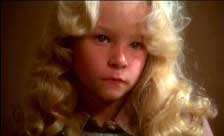 Previously
released on VHS in 1983 by Vestron, THE GODSEND gets its digital debut in this
set in an interlaced, anamorphic widescreen (1.66:1) transfer. It does not appear
to be a new transfer; the image looks drab overall – only partially due
to the original cinematography – and the red opening and closing credits
are sometimes difficult to read. According to the BBFC, THE GODSEND was released
theatrically in 1980 with a 90 minute 27 second running time. The 86 minute
6 second running time of the Scream Factory transfer would suggest a PAL-to-NTSC
conversion if not for the fact that the BBFC also lists the PAL running time
of the 1986 Rank video release as 82 minutes and 19 seconds. This suggests that
the film was trimmed down for international exhibition after the UK theatrical
release and that version ended up on videotape (the Cannon production LINK ran
115 minutes in its UK theatrical release but all subsequent editions have been
the 102 minute international cut).
Previously
released on VHS in 1983 by Vestron, THE GODSEND gets its digital debut in this
set in an interlaced, anamorphic widescreen (1.66:1) transfer. It does not appear
to be a new transfer; the image looks drab overall – only partially due
to the original cinematography – and the red opening and closing credits
are sometimes difficult to read. According to the BBFC, THE GODSEND was released
theatrically in 1980 with a 90 minute 27 second running time. The 86 minute
6 second running time of the Scream Factory transfer would suggest a PAL-to-NTSC
conversion if not for the fact that the BBFC also lists the PAL running time
of the 1986 Rank video release as 82 minutes and 19 seconds. This suggests that
the film was trimmed down for international exhibition after the UK theatrical
release and that version ended up on videotape (the Cannon production LINK ran
115 minutes in its UK theatrical release but all subsequent editions have been
the 102 minute international cut).
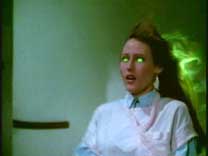
In THE OUTING, the grisly murder of an extremely elderly Arab woman in her house by quickly dispatched robbers reveals a horde of antiquities from the Middle East (including a 3,500 year old lamp). The items wind up at the Texas Museum of Natural History where Dr. Wallace’s (James Huston, THE BOSTONIANS) BLOSSOM-hat-wearing daughter Alex (Andra St. Ivanyi) rubs the lamp and unleashes a malevolent Claymation djinn (voiced by Jackson Bostwick, SHAZAM!’s Captain Marvel). The djinn possesses Alex and convinces her high school friends to spend the night with her in the museum. They are not the only unwanted visitors since Alex’s rapey ex-boyfriend Mike (Red Mitchell, FOREVER EVIL) and his buddy Tony (André Chimène) have also snuck into the museum in order to get even with Alex and her boyfriend (Scott Bankston); but the djinn has plans for all of them.
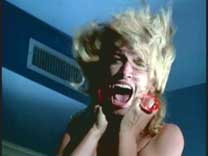 Released
overseas under the more fitting title THE LAMP, the Texas-lensed THE OUTING
– no more commercial a title and not to be confused with Byron Quisenberry’s
literal 1981 sleeper released as SCREAM – should be a guilty pleasure
with attractive teens having sex and being gorily dispatched (it also predates
WISHMASTER with its malevolent djinn character). That said, its exploitation
elements are often simply unpleasant: from Mike’s battering of Alex (despite
his subsequent ass-kicking) to the rape of one of her friends. Associate producer
Deborah Winters (BLUE SUNSHINE) plays three roles in the film (well, two in
the US version): Alex’s ass-kicking teacher (who is secretly dating her
father) and the Arab woman under make-up; but she seems more to be “filling
in” since her principal character actually has little influence on the
story (which pretty much precedes exactly how one expects it will). The film
does feature some interesting and attractive production design by Robert Burns
(THE TEXAS CHAINSAW MASSACRE) make-up effects by John Naulin (FROM BEYOND) and
Gabe Bartalos (LEPRECHAUN), and visual effects by exploitation director David
L. Hewitt (THE WIZARD OF MARS).
Released
overseas under the more fitting title THE LAMP, the Texas-lensed THE OUTING
– no more commercial a title and not to be confused with Byron Quisenberry’s
literal 1981 sleeper released as SCREAM – should be a guilty pleasure
with attractive teens having sex and being gorily dispatched (it also predates
WISHMASTER with its malevolent djinn character). That said, its exploitation
elements are often simply unpleasant: from Mike’s battering of Alex (despite
his subsequent ass-kicking) to the rape of one of her friends. Associate producer
Deborah Winters (BLUE SUNSHINE) plays three roles in the film (well, two in
the US version): Alex’s ass-kicking teacher (who is secretly dating her
father) and the Arab woman under make-up; but she seems more to be “filling
in” since her principal character actually has little influence on the
story (which pretty much precedes exactly how one expects it will). The film
does feature some interesting and attractive production design by Robert Burns
(THE TEXAS CHAINSAW MASSACRE) make-up effects by John Naulin (FROM BEYOND) and
Gabe Bartalos (LEPRECHAUN), and visual effects by exploitation director David
L. Hewitt (THE WIZARD OF MARS).
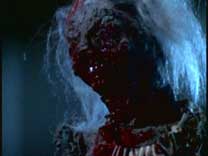 Scream
Factory’s fullscreen transfer of THE OUTING is derived from an aged interlaced
tape master of the US R-rated theatrical version (87:57), presumably the same
one that was used for the 1986 International Video Entertainment VHS edition.
Colors are stable but blacks can be a bit hazy, while the Dolby Digital 2.0
rendering of the Ultra Stereo track fares better. The international prints of
the film bore the original title THE LAMP (88:52) and featured a period flashback
sequence under the opening credits (the US credits were on black) in which a
ship carrying artifacts from Damascus reaches the Texas Gulf Coast port with
the crew slaughtered, with a young Arab woman (the third of Walters roles in
the film) as the only survivor. It’s strange that this sequence was deleted
from the US releases because it adds some production value to the film, but
it isn’t essential (this version was released in the UK on VHS and then
later VHS-quality barebones DVD, but with BBFC-mandated cuts to the rape scene
which may or may not be a plus). (Eric
Cotenas)
Scream
Factory’s fullscreen transfer of THE OUTING is derived from an aged interlaced
tape master of the US R-rated theatrical version (87:57), presumably the same
one that was used for the 1986 International Video Entertainment VHS edition.
Colors are stable but blacks can be a bit hazy, while the Dolby Digital 2.0
rendering of the Ultra Stereo track fares better. The international prints of
the film bore the original title THE LAMP (88:52) and featured a period flashback
sequence under the opening credits (the US credits were on black) in which a
ship carrying artifacts from Damascus reaches the Texas Gulf Coast port with
the crew slaughtered, with a young Arab woman (the third of Walters roles in
the film) as the only survivor. It’s strange that this sequence was deleted
from the US releases because it adds some production value to the film, but
it isn’t essential (this version was released in the UK on VHS and then
later VHS-quality barebones DVD, but with BBFC-mandated cuts to the rape scene
which may or may not be a plus). (Eric
Cotenas)